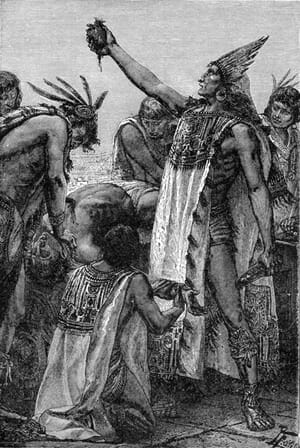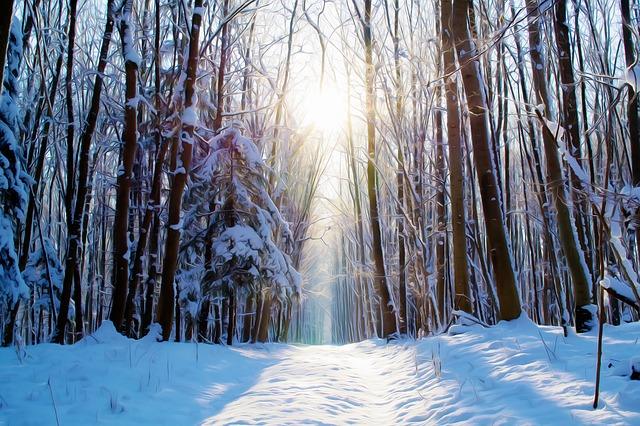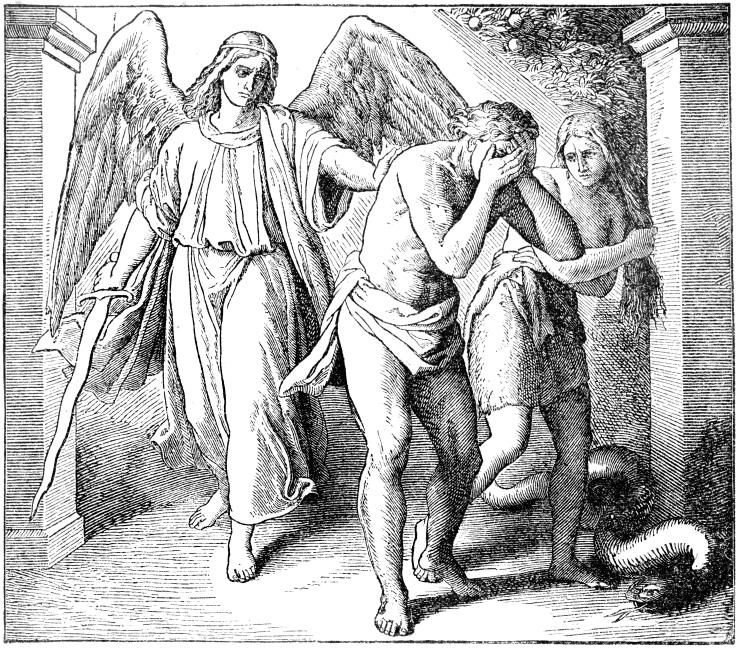Save on Adorable Noah’s Ark Baby Bedding, Toys, Accessories & More! -Web Ad
Lyell is most firmly convinced that he has shaken the faith in the Deluge far more efficiently by never having said a word against the Bible, than if he had acted otherwise. -Charles Darwin
 What do an ancient Aztec rite, a dusty three-volume book on rocks, and the décor of children’s nurseries have in common? They may all be responses to something in humanity’s collective past, something too horrible to forget, something too painful to remember.
What do an ancient Aztec rite, a dusty three-volume book on rocks, and the décor of children’s nurseries have in common? They may all be responses to something in humanity’s collective past, something too horrible to forget, something too painful to remember.
In The Midnight Hour
A long, long time ago, further south of what is now our southern border, a procession of priests, each dressed as one of the great gods, crossed the causeway over a great lake and slowly ascended the sacred Hill of the Star. There, at a shrine to the fire god, the priests took their place around an altar. They readied their sacrifice, a prince or captain of high standing. Then the priests turned their eyes heavenward and anxiously fastened them on the slowly climbing Pleiades. As the star cluster reached its midnight hour, the priests turned to their sacrificial victim, tore his heart from his chest, and offered it to their god. Then, in the victim’s chest cavity, one priest placed a fireboard. Into it he drove a stick, a fire drill, that he spun back and forth between his palms to start a fire. When the sparks burst into a steady flame, the priests took the fire and used it to ignite an enormous bonfire, one visible across the valley for miles. Into it that bonfire the priests threw the victim’s body. Then, relay runners lit flaming torches from the bonfire and ran to the central temple to light its fires, and from there the fire was carried to other temples and finally to people’s homes. The rite ended when the priests bound together fifty-two sticks, each representing a year, and buried them with ceremony.
This midnight ritual was Aztec, though it likely predates their civilization. Its goal was to prevent the end of the world. If the ceremony failed, the star demons would descend upon the Earth and devour mankind. Ouch.
Five Suns and the Need for New Fire
Aztec history is made up of five “suns” or eons. Each began as a god sacrificed himself to set a new sun ablaze to get the cosmic motor running. Each period ended in a cosmic catastrophe—wind, fire, or flood. The fifth sun, ours, is to perish in a great shaking. Until then, the earth, the sun—the age, the cosmos and even time itself—was to be fueled by blood from human sacrifices. After all, time had begun by the god’s own sacrifice. But the crucial sacrifice came at a key moment carefully worked out in the Aztec calendar.
You see, the Aztec calendar was a very complicated affair. On top of an agricultural calendar of 365 days, the Aztecs had another calendar, one based on a count of 20 day-signs multiplied by 13 variations (260 days). The two reckonings coincided after fifty-two years at the beginning of what is our November. That day was not only crucial, but tentative. In the moment between one calendar round and the next, the whole universe could end with a pretty big bang. (It had ended before four times.) The last time had involved a great flood when the imprisoned waters beneath the earth broke forth and the heavens collapsed. This was a part of Aztec history the ritual could not ignore.
Day of The Dead
When the Conquistadors took control of Mexico, they tried to suppress the worst elements of Aztec sacrificial worship. But beliefs die hard, and many aspects of the midnight ritual remained. In some cases, the Church assimilated these into its own local practices. One example is the “Mexican Day of the Dead,” El Día de los Muertos. The Aztec festival of the dead actually fell in our August and it lasted for an entire month. Its festivities were dedicated to Mictecacihuatl, the Lady of the Dead. But the Church pulled those festivities into November and blended them into its own longstanding festival, All Souls’ Day. The transition seems to have been easy enough, perhaps because All Souls’ Day coincided with day of the Aztec midnight hour ceremony.
The Church as Synthesizer
This was not the first time the Church had tried to impose its own holy day over a popular pagan festival. In what had been Celtic Europe, Samhain was the beginning of the new year. It was recognized as a time when the barriers between this world and the next would wear thin, and the dead would draw near. The Church supplanted Samhain with All Saints’ Day, a holiday originally set on May 1st, where it had been overlaid on a Roman festival for the dead. All Saints’ Day, or All Hallows, commemorates the saints who have reached Heaven. The evening before, of course, is All Hallows’ Eve—what Americans call Halloween.
Global Coincidence?
19th Century scholars (often quoting one another) have pointed out that festivals like Samhain and the Mexican Day of the Dead were common across our planet and throughout our history, and that many of them fell at the beginning of November when the Pleiades reached the meridian. The rites for Osiris in ancient Egypt, the Persian month of Mordad, the Incan Day of the Dead, the Chinese Ghost Festival, and the Roman Feralia are on their lists. One thing is certain—the collective ancient world at some point was haunted by death… on a global scale.
When the Skies of November Turn Gloomy
The beginning of November is an odd time, and the Pleiades star cluster an odd marker. Why not the equinox or the solstice? Neither is far away. In fact, the equinox is only about a month and half earlier, around September 23rd. Some writers point to the shortening of daylight hours or to the end of harvest, but neither has a natural border or marker. The Bible, however, presents us with another option. The book of Genesis tells us that more than 4000 years ago something did happen about a month and half after the autumnal equinox, something terrible. On that day, the whole world died.
In the six hundredth year of Noah’s life, in the second month, the seventeenth day of the month, the same day were all the fountains of the great deep broken up, and the windows of heaven were opened. And the rain was upon the earth forty days and forty nights… and all flesh died (Gen. 7:11-12, 21).
Earth’s original calendar began at the equinox: it was the day the earth was born. Genesis says that 1656 years later, one month and seventeen days after the beginning of the year, the Flood came. It came not as an astronomical accident nor as a metaphysical anomaly, but as covenantal judgment from the infinite-personal Creator God. It came because of man’s sin.
Flood Myths
The histories and legends of the world are full of stories of a great Flood that destroyed the world. These stories come from ancient Europe, from the Middle East, from the early Americas, from the Pacific Islands, and from the aborigines of Australia. Most of the stories mention a boat and the salvation of a small number of humans, often one favored family. Many connect the Flood to divine wrath. A few mention birds used for reconnaissance (Gen. 8:7-11). Generally, the further from Ararat each story comes, whether in time or space, the more it deviates from the account in Genesis. But most nations before the modern age have believed in some sort of universal Deluge.
Rise of the Lyellcans
Until the 18th Century, most educated men still took the story of the Flood as fact. Early geologists even factored it into their understanding of observable strata. Sir Charles Lyell (1797-1875) was the first to argue at length for a geology that rejected catastrophism on principle. Though he did not address the Flood directly (this was deliberate on his part) he argued that currently observed natural processes operating over sufficient amounts of time (millions of years) were enough to account for the geological condition of our planet. This philosophy was soon labeled uniformitarianism. Lyell’s arguments came in a three-volume book, Principles of Geology. It was first published in 1830, a quarter century before Darwin’s Origin of Species. Lyell was Darwin’s mentor.
In the first century, the apostle Peter foretold the rise of the Lyellcans:
Knowing this first, that there shall come in the last days scoffers, walking after their own lusts, and saying, Where is the promise of his coming? for since the fathers fell asleep, all things continue as they were from the beginning of the creation. For this they willingly are ignorant of, that by the word of God the heavens were of old, and the earth standing out of the water and in the water: whereby the world that then was, being overflowed with water, perished: but the heavens and the earth, which are now, by the same word are kept in store, reserved unto fire against the day of judgment and perdition of ungodly men (2 Pet. 3:3-7).
“Willingly ignorant,” Peter says. In other words, this is not about geological evidence, of which there’s plenty (as Lyell knew); it’s about willing suppression. This suppression continues today.
Children’s Nurseries Safe and Warm
We fill our children’s nurseries with images of Noah’s ark. There are blankets, picture frames, mobiles, and toys. All symbols of the winners that made it, safe and dry. But about the folks that didn’t make it? Even those who don’t believe the Bible should understand that the ark also recalls the drowning deaths of millions, perhaps billions, of men, women, and children, all in a single day. The cute, cartoon-like images of the ark, always complete with giraffes sticking their heads out its top, illustrate only part of the story, the happy-ending part.
Conclusion
The ancients hid behind ritual and magic. Modernity hides behind denial and pseudoscience. However, fear of catastrophes remain. As 2012 approaches, the need for “strange fire” will grow. The news will be full of solar flares and cosmic storms. The Federal Reserve priests recently started another fire. But to hip intellectuals on the right and the left, the Genesis Flood is a clearly ridiculous non-event. It speaks much too clearly that there is judgment in time and space. Some thoughts are best left in children’s nurseries.
If you liked this article you may be interested in this product from our sponsor.










